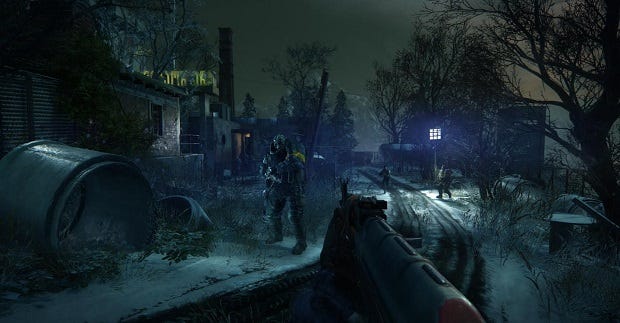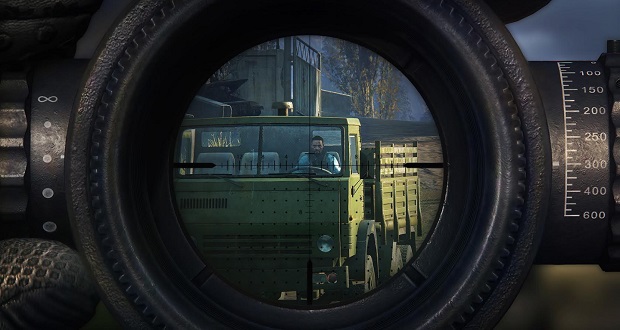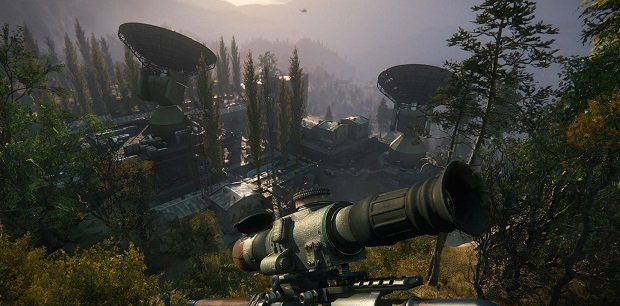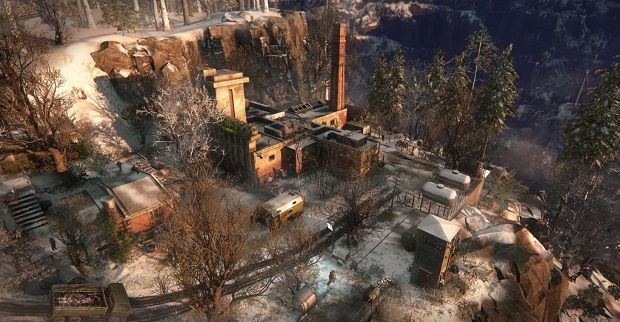Sniper Ghost Warrior 3 is an off-brand Far Cry game
Through a glass darkly
We sent Edwin Evans-Thirwell into the field to see Sniper Ghost Warrior 3 [official site] and he came back to us with a report about the good, the bad and the ugly of the game, and thoughts on the loneliness of the long distance killer.
Sniper rifles are ubiquitous in video games, but I'm not sure a game has ever captured what it means to be a sniper – or to face one. These guns are characterised as delicate tools, the preserve of a methodical elite, but while sniping may require subtlety, a sniper rifle is essentially an instrument of terror.
Forget neat, decorous holes in foreheads – a 50 calibre rifle can hit a target over a mile away with more force than a point-blank magnum blast, ripping through concrete or body armour to erase limbs and shatter machinery. I can only imagine the long-term psychological effects of living in the shadow of such weapons. Moreover, to be a sniper means killing people who, much of the time, pose no direct threat. A soldier on the frontline has the instinct of self-preservation to fall back on, but how do you drum up the requisite bloodlust when your enemy is 1700 metres off and blissfully unaware of your presence?
There's real need for a sniper game that explores this side of what has become an excessively valorised archetype in video game fictions. Sniper Ghost Warrior 3 doesn't appear to be that game, though it's a shade more involved than the average military boomfest. The focus here is squarely on dispassionate questions of craft and technique – scouting out guard patrol patterns, finding the right vantage point, adjusting your sights to compensate for a myriad of ambient factors, and waiting for your moment. While its predecessors were linear affairs, this instalment features open world environments where you'll pick missions at a safehouse and craft equipment before making your merry way to the unfortunate mark.
Sniping isn't mandatory in Sniper Ghost Warrior 3. As the title suggests, you can also sneak into locations and bag your man up close, or let rip from a window with an assault rifle or shotgun. There are missions where you needn't spill blood at all – a mission to sabotage a radar array by cracking terminals, for example – and each of the game's three battlefield styles has its own unlock tree. But sniping remains the heart of the game, and benefits most obviously from the expanded canvas. Every structure or scenario - fortified churches, water-logged apartment blocks, trashed railyards and village squares - can be assailed from several angles, every VIP taken out from Sir or Madam's choice of elevations using an array of ammunition types and calibres.
The execution leans a bit harder towards realism than is usual for a shooter, while stopping well short of being a full-on simulation. The old “red dot” HUD aid from the previous games is gone, regardless of difficulty mode, so you'll need to compensate for distance and wind pull yourself (sparingly available DARPA rounds do some of the work for you by course-correcting on the fly). You'll also have to worry about bullets passing through bodies to create a disturbance elsewhere, though this is obviously an opportunity to save ammo if you line up a pair of sentries just right.
There's a generic magic vision mode to help you pin down hostiles, but the thick undergrowth and weary, post-Soviet pallor of the art direction are a little harder to scan than the exotic trappings of the average Far Cry. The influence of Ubisoft's series is felt in the addition of an aerial drone, used to mark guards and objects of interest on your HUD. These range from explodable fuseboxes and hackable CCTV cameras to optimal vantage points. Reaching the latter may involve a bit of platform-puzzling - during one mission I had to clamber up and around a ruined tenement building, hauling myself onto balconies and through holes in ceilings while avoiding the gaze of a sniper in the high rise opposite.
Open gunfights can be chaotic, as accuracy plunges when you shoot while moving and there's no automatic health replenishment – you'll need to chug pills or bandage your injuries to recover segments of the bar. Protagonist John North can sprint, slide and ADS with the best of them, however, and the soldier AI isn't all that sharp – there's that familiar mix of inhuman perception once alerted, and idiotic readiness to follow each other straight into a killzone. If you favour the quieter kind of invasion, there are ledge-kills and drop-kills to try your hand at, plus remote- and proximity-detonated explosives. Guards can also be interrogated about troop positions when grabbed from behind.
It's a respectable foundation for mayhem, but it lacks a memorable flourish, and the limitations of the team's vision (and the project's resources) are easy to spot. The game is set in present-day Georgia, and sees your character walking the line between three warring factions as you search for your missing brother, but it often feels like it's happening in the background art to “All Ghillied Up”. The map I sampled is dense with cover, but it's a spartan creation beneath the visual noise, dotted with half-hearted distractions such as lootable towers (there don't appear to be any map-unlocking radio masts, at least). A few glum-faced civilian drivers do their best to keep up the illusion of an indigenous society. I shot one of them, more out of pity than malice, and the man only grunted, put his vehicle into gear and vanished on the spot. It's neither a convincingly realised place nor an excitingly reactive sandbox, just ground to be crossed on your way to a headshot.
The “drawback” of a sniper scope is that it fosters a troubling intimacy. A sniper tracking a target might notice how the victim carries himself, how he favours one leg, how he listens or fidgets, the tics and quirks that identify him irresistibly as a fellow being. Real-life sniper accounts often address the turmoil of getting to know a target a little too well - however secure in your commitment to the cause, you might end up feeling unable to take the shot. I've yet to have that experience in a game like Sniper Ghost Warrior 3, and there are an awful lot of games like Sniper Ghost Warrior 3. The prospect of an off-brand Far Cry with a dash of Battlefield isn't to be sneezed at, but still – imagine if all the time given over to fine-tuning the rifle handling had been spent making your victims act like people.












